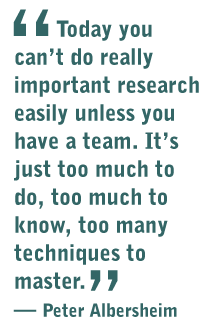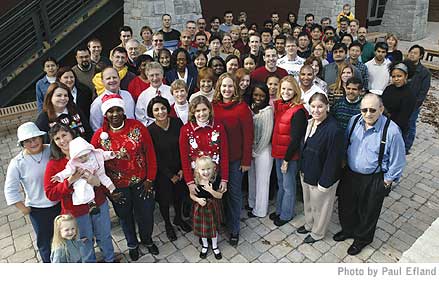


Sweet Dreams
by Kathleen Cason
Intro
| Charting the course
| The team's beginnings
| The pitch
Cross-country caravan
| The gathering
| Collaborations


The gathering
Over the past 18 years, the CCRC has assembled an international cast of faculty, visiting
scientists, researchers and students. They have arrived from top universities worldwide: Johns
Hopkins, Emory, Oxford, Cambridge, MIT, Berkeley, Cal Tech, Harvard, Yale, Cornell and the Weizmann
Institute. And they have haled from nearly every continent.
For example, one recruit, Geert-Jan Boons, was a professor at the University of Birmingham in
England when Albersheim invited him to give a talk at the CCRC. Albersheim casually mentioned that
a CCRC faculty position was open.
“Well, Peter is a big name in his field so I thought, ‘Let’s be polite. He’s paying my expenses.’ I
never contemplated actually moving to the United States,” Boons said. “But I was impressed by the
facility and I also was impressed by the way they did things. Most places try to hire someone and
then see whether they have space. Peter does it the other way around. They built the space,
confident that they would go out and find someone good.”
Another recruit was long-time CCRC advisory committee member James Prestegard from Yale University.
Prestegard, now one of 12 Eminent Scholars at UGA, helped pioneer the use of NMR to study how cell
surface carbohydrates interact with biologically important proteins. Prestegard called his move “a
really good opportunity” especially given recent changes in science that favor “collaborative
groups [in order] to make progress on big problems.”
By 2003, 15 faculty members had joined the CCRC. Each leads a group of senior scientists,
technicians, post-doctoral associates, and graduate and undergraduate students. The CCRC includes
experts in computer science, plant science, physics, microbiology, biochemistry, electron
microscopy, molecular biology and chemistry, among other fields.
“Today it’s nearly impossible to do important research easily unless you have a team. It’s just too
much to do, too much to know, too many techniques to master,” Albersheim said.

More than 200 scientists, students and staff
moved into a new 140,000-square-foot CCRC
facility in fall 2003.
Intro
| Charting the course
| The team's beginnings
| The pitch
Cross-country caravan
| The gathering
| Collaborations
For comments or for information please e-mail the editor: jbp@ovpr.uga.edu
To contact the webmaster please email: ovprweb@uga.edu
![]()